Fishing around in Chilaw
Driving past lush paddy fields and bountiful coconut plantations, glimpsing stately walauwas, our ‘All In A Day’ travel series takes us to Chilaw, some 79 kilometres from Colombo. Its diversity immediately hits us; fertile land, immaculate beaches, old churches and kovils, timeworn architecture and the sparkling waters of the lagoon.
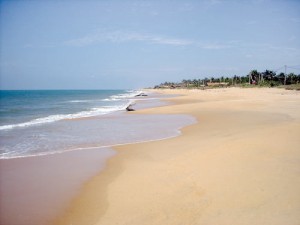
Tranquil beaches
After a two-hour journey, our first stop was the Chilaw Fish Market where we were  assailed by the smell of fish and the salty sea breeze. Located on Bishop Edmund Pieris Mawatha along the Dutch Canal, the fish auction was in progress as we arrived. A vibrant scene unfolded: Fishermen unloading tangled nylon nets off their boats, disentangling them to pick off the Saalaya or Hurullo as the mudalalis argued loudly with customers. Up on the rampart teenagers were fishing with rod and hook. Crows circled overhead on the lookout for discarded fish heads.
assailed by the smell of fish and the salty sea breeze. Located on Bishop Edmund Pieris Mawatha along the Dutch Canal, the fish auction was in progress as we arrived. A vibrant scene unfolded: Fishermen unloading tangled nylon nets off their boats, disentangling them to pick off the Saalaya or Hurullo as the mudalalis argued loudly with customers. Up on the rampart teenagers were fishing with rod and hook. Crows circled overhead on the lookout for discarded fish heads.
The boats leave to sea either during the early hours of the morning or in the evening. They call the evening shift – Mayyakkama and this catch is reserved for making dried fish. The Chilaw Fish Market is known for its low prices thanks to a good supply during the season.
Wrapping you up in tranquillity is the pristine beauty of the Chilaw beach, blissfully deserted save for a few local lovers and fishermen going out to sea in rowing boats called theppama. Flocks of seagulls tread the sand, pecking for baby crabs on the rock bed where algae and coral freely grow. With a rock barrier providing protection against erosion, the Chilaw beach was spared the 2004 tsunami wave.
As you stroll between Ambakandawila and Iranawila, there is a must-stop place where you come across the rare sight of Maadel fishing which is a seasonal activity between October and April. Here a large net is laid in the deep sea with the ends directed back to the coast and pulled in by a group of fishermen and women from the beach some 600 metres away. The net is laid at least twice a day based on the tide. Stop for a chat with this fishing community and who knows, you may be invited to their “wadiya” for a meal.
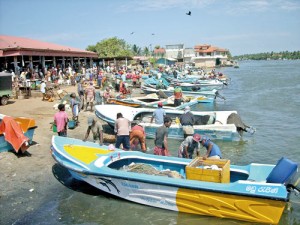
bustling activity at the fish market. Pix by Augustine Fernando
There are churches in abundance with the serene statues of Mother Mary and the Saints looking down, indicating the strong presence of the Christian community in the area. The Anglican church dated 1831 perched on a slender hilltop overlooking the Chilaw lagoon – St. James’ Church can be traced back to the time when a community of weavers migrated here from India during Dutch rule. This particular location became a regular assembly point of prayer for them and after the British took over the maritime provinces, a temporary structure was put up for worship. The church proper was built in 1831 by the Provincial
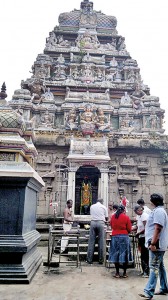
Worshippers at the Munneswaram Kovil
Collector and Judge, F.J. Templar. The Church can be accessed through Weavers’ Street –named after the weaving community who lived there in the days gone by. Villagers believe that the Sinhalese term Halavata (Chilaw) was derived from the number of ‘Salavas’ (halls) built in the city for use by the weaving industry. As a number of weavers settled down in the area, it had acquired the name Salavagama (village of halls) which later came to be known as Halavata.
Traces of the colonial past are seen in the present High Court complex facing the Chilaw- Puttalam Road which is said to have served as the District Court premises during the British period and the old Magistrate’s Court which now contains both the Magistrate and the District Courts and has a clock tower with a colonial look.
Right opposite the High Court complex is a derelict bungalow called “Sigiri Walauwa” which is of great significance as Mahatma Gandhi is said to have stayed a night here during one of his visits to Sri Lanka.
Our day concluded with a stop at the Munneswaram Kovil cluster about two km from the main town, reached via the Kurunegala Road. The complex with its bright red, blue and yellow painted walls as well as figures of deities houses shrines dedicated to Lord Shiva and Badhra Kali Amman, in close proximity to each other as Kali is
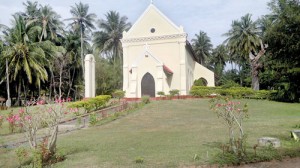
St. James Church: Harks back to the time when a community of weavers migrated here from India during Dutch rule
considered to be an Avataram of Lord Shiva’s wife Parvathi. Where there is a shrine for Lord Shiva, there has to be a shrine dedicated to Goddess Kali close by, a priest in the kovil told us. As Kali is believed to give protection from enemies, the sacred site is visited not only by Hindus, but also people from all religions seeking blessings. The history of the kovil is closely associated with Prince Rama who it is said built the kovil to redeem a vow he made during his mission to Sri Lanka to find his wife Sita.
Controversial due to the animal sacrifice issues of recent years, Munneswaram is nevertheless also of considerable historic interest- the site along with the presiding statue of Kali and a Shivalingam believed to be centuries old.
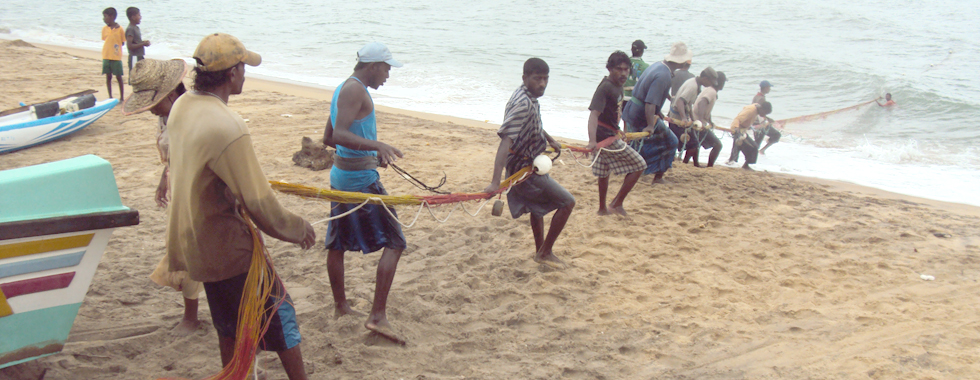
A must see: Maadel fishing


